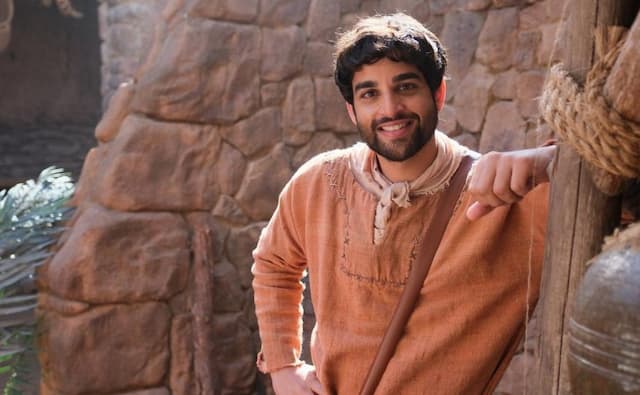Holman Hunt–The Scapegoat | Dreaming Beneath the Spires

Inscribed on the frame:
‘Surely he hath borne our Griefs, and carried our Sorrows/Yet we did esteem him stricken, smitten of GOD, and afflicted.’ (Isaiah LIII, 4)
‘And the Goat shall bear upon him all their iniquities unto a Land not inhabited.’ (Leviticus XVI, 22)
Subject
This was the first major painting Hunt made during his first stay in the Holy Land. He had the idea for the picture while studying the Talmud (the collection of ancient Rabbinic writings that forms the basis of religious authority in Orthodox Judaism) for information on Jewish ritual for his painting ‘The Finding of the Saviour in the Temple’ (now in Sudley House). Hunt’s researches disclosed that on the Festival of the Day of Atonement, a goat was ejected from the temple with a scarlet piece of woolen cloth on its head. It was goaded and driven, either to death or into the wilderness, carrying with it the sins of the congregation. It was believed that if these sins were forgiven the scarlet cloth would turn white. Hunt regarded the Old Testament scapegoat as a prefigurement of the New Testament Christ whose suffering and death similarly expunged man’s sins.
In the Book of Leviticus (which is quoted on the frame) the goat is said to bear the iniquities into a land that was not inhabited. Hunt chose to set his goat in a landscape of quite hideous desolation – it is the shore of the Dead Sea at Osdoom with the mountains of Edom in the distance. In his diary Hunt described this setting as ‘a scene of beautifully arranged horrible wilderness’ and he saw the Dead Sea as a ‘horrible figure of sin’, believing as did many at this time that it was the original site of the city of Sodom.
Initially, Hunt considered that the subject might be suitable for the animal painter Landseer, who, in the 1840s, had taken to producing threatening symbolic lochside scenes with deer. However, in March 1855, Hunt wrote to Rossetti saying that it was seeing for the first time the extraordinary sight of the Dead Sea that decided him to tackle the subject himself. Hunt returned to the edge of the sea with guides and spent about two weeks painting in the landscape and making sketches and notes. He took a white goat with him but he left blank that part of the picture that the animal occupies and did not paint the beast until he returned to his Jerusalem studio. Whilst at Osdoom, Hunt’s life was at risk from hostile tribesmen. The insistence of his guides that they get away from this dangerous spot led to his leaving earlier than he wished. He took back samples of mud and salt to help him finish the foreground. In Jerusalem Hunt also bought or borrowed sheep and goat skulls and a full camel skeleton.
Lever bought the picture in 1923 for £4950. It was exhibited at theWalker Art Gallery in the 1923 Autumn Exhibition and was then transferred to the Lady Lever Art Gallery.
Elsewhere on the web
In 2009, the BBC television drama ‘Desperate Romantics’ – about the Pre-Raphaelite artists Dante Gabriel Rossetti, William Holman Hunt and John Millais – featured ‘The Scapegoat’ in episode four of the series. See a zoomable version of the painting with expert commentary on the BBC website.
The Azazel goat (pronounced in Hebrew as aw-zah-zale), translated as scapegoat in the King James Version, was one of two goats chosen for a ceremony on The Day Of Atonement. The first goat was sacrificed, while the scapegoat was taken out into the wilderness and released.
 “Then he shall take the two goats, and set them before The Lord at the door of the tent of meeting; and Aaron shall cast lots upon the two goats, one lot for The Lord and the other lot for Azazel. And Aaron shall present the goat on which the lot fell for The Lord, and offer it as a sin offering; but the goat on which the lot fell for Azazel shall be presented alive before The Lord to make atonement over it, that it may be sent away into the wilderness to Azazel.” (Leviticus 16:7-10 RSV)
“Then he shall take the two goats, and set them before The Lord at the door of the tent of meeting; and Aaron shall cast lots upon the two goats, one lot for The Lord and the other lot for Azazel. And Aaron shall present the goat on which the lot fell for The Lord, and offer it as a sin offering; but the goat on which the lot fell for Azazel shall be presented alive before The Lord to make atonement over it, that it may be sent away into the wilderness to Azazel.” (Leviticus 16:7-10 RSV)
“And when he has made an end of atoning for The Holy Place and the tent of meeting and the altar, he shall present the live goat; and Aaron shall lay both his hands upon the head of the live goat, and confess over him all the iniquities of the people of Israel, and all their transgressions, all their sins; and he shall put them upon the head of the goat, and send him away into the wilderness by the hand of a man who is in readiness. The goat shall bear all their iniquities upon him to a solitary land; and he shall let the goat go in the wilderness.” (Leviticus 16:20-22 RSV)




